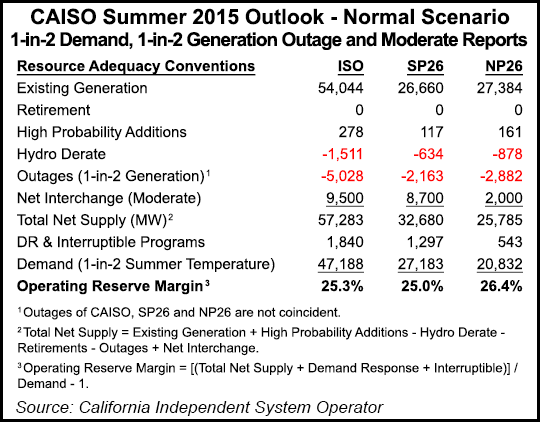Despite Drought, California Has Strong Summer Power Outlook, CAISO Says
Even if the summer turns much hotter than normal, drought-plagued California will have plenty of electricity, according to a recent assessment by the California Independent System Operator (CAISO).

Peak demand is expected to hit more than 47,000 MW, about 1,000 MW greater than last year, and overall in-state generation totals more than 54,000 MW.
While the state’s hydroelectric supplies will be down, natural gas-fired, renewable and imported hydropower supplies will more than make up the difference. The state faces this summer with an operating reserve margin of more than 25%, CAISO said in its latest summer assessment.
“Our assessment shows we have the resources available to meet California’s needs this year,” said CAISO CEO Steve Berberich, adding that summer heat-spiked electricity loads are always a challenge. “We will keep a close watch on the system, particularly in Southern California where fires, high demand and transmission congestion can cause concerns.”
The fourth consecutive year of drought has reduced hydroelectric supplies, but the CAISO report concluded that this factor “will not materially impact the reliability of the CAISO system due to significant renewable generation additions, sufficient imports and moderate peak demand growth.”
As of mid-April, the state water report placed the California’s precipitation at 58% of normal; 4% of normal for the April 1 average snowpack water content; and reservoirs overall at 60% of average levels.
CAISO said it was tracking the availability of gas-fired and other thermal generation among all facilities available that are 20 MW or greater in capacity. Four gas-fired power plants that last year were tagged as having potential water supply concerns, according to the CAISO report, now “have addressed the [water] issues by establishing alternatives or by monitoring and managing groundwater supply.”
Part of the grid operator’s assuredness for the summer is based on an expected total of 2,328 MW of added renewable-based power supplies expected this summer. The vast majority (96%) of the additional power is from solar installations with the rest coming from wind (3.4%) and biogas (0.6%)
In addition, CAISO’s report counts on about 9,500 MW of imported power from the Pacific Northwest mostly. The Northwest River Forecast Center projected that April through August water at the Dalles Dam on the Columbia River will be 80% of normal.
© 2024 Natural Gas Intelligence. All rights reserved.
ISSN © 1532-1231 | ISSN © 2577-9877 | ISSN © 1532-1266 |
